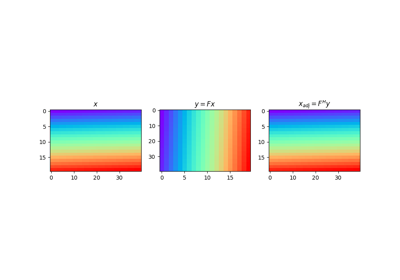pylops.Transpose¶
-
class
pylops.Transpose(dims, axes, dtype='float64')[source]¶ Transpose operator.
Transpose axes of a multi-dimensional array. This operator works with flattened input model (or data), which are however multi-dimensional in nature and will be reshaped and treated as such in both forward and adjoint modes.
Parameters: Raises: - ValueError
If
axescontains repeated dimensions (or a dimension is missing)
Notes
The Transpose operator reshapes the input model into a multi-dimensional array of size
dimsand transposes (or swaps) its axes as defined inaxes.Similarly, in adjoint mode the data is reshaped into a multi-dimensional array whose size is a permuted version of
dimsdefined byaxes. The array is then rearragned into the original model dimensionsdims.Attributes: Methods
__init__(dims, axes[, dtype])Initialize this LinearOperator. adjoint()Hermitian adjoint. apply_columns(cols)Apply subset of columns of operator cond([uselobpcg])Condition number of linear operator. conj()Complex conjugate operator div(y[, niter, densesolver])Solve the linear problem \(\mathbf{y}=\mathbf{A}\mathbf{x}\). dot(x)Matrix-matrix or matrix-vector multiplication. eigs([neigs, symmetric, niter, uselobpcg])Most significant eigenvalues of linear operator. matmat(X)Matrix-matrix multiplication. matvec(x)Matrix-vector multiplication. rmatmat(X)Matrix-matrix multiplication. rmatvec(x)Adjoint matrix-vector multiplication. todense([backend])Return dense matrix. toimag([forw, adj])Imag operator toreal([forw, adj])Real operator tosparse()Return sparse matrix. trace([neval, method, backend])Trace of linear operator. transpose()Transpose this linear operator.
